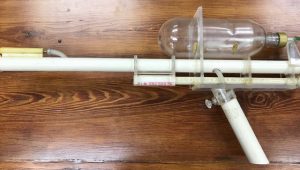Lets talk about the super soaker; the 2011 toy of the year and member of the Toy Hall of Fame.
The Creation
Lonnie Johnson grew up as the epitome of those insanely skilled kids you see innovating from childhood. He later became an Airforce and NASA engineer. While working on a water-based refrigerator system for the Galileo project, he hooked up a nozzle to his bathroom sink and immediately had a stroke of genius.
Simply put, Johnson said the following, “I was working on a heat pump that used water as a working fluid, and I made some jet pumps for it. I accidentally shot a stream of water across a bathroom where I was doing the experiment and thought to myself, ‘this would make a great gun.’
He then went back to the Airforce to work on the B-52 Stealth bomber, creating the super soaker in his basement on his own. He eventually finished it out of PVC pipes, plexiglass, O-ring seals, and a two-litre soda bottle. This started his hunt to commercialize it. These guns were separate from the typical other water guns of the time, using manually pressurized air. It had beaten all competition in power, range, and accuracy. Despite this, the hunt was an immense struggle.
Commercializing the Super Soaker
It took 7 straight years to find a company willing to shelve the super soaker. At the 1989 International Toy Fair, Johnson met the vice president of Larami. As such, this VP offered Johnson a business opportunity, should he find himself in Philadelphia. Johnson took that chance, demonstrating the super soaker in his successful pitch, and put out the first line of the gun in 1990. It started out with the name “Power Drencher” but then was later changed to its current name, and sold 2 million versions in the following summer.
Afterward, Johnson went back to NASA briefly, then joined Hasbro to work on their nerf line. He has since earned over 100 patents, and currently mentors our generation of scientists. He places a focus on POC youth, such that every individual gets a chance to contribute and innovate to our advancing society.
More Niche Information about the Super Soaker
- If you search up Lonnie Johnson, most of the pictures are just of him holding a Super Soaker. Like this!
- There are 20 total series of Super Soakers (as listed on the Nerf Wiki) and then 5 more sub-series. The most recent are the Dinosquad and Bunkr Series.
- Each gun uses one of the technologies as follows to shoot.
- Piston Pumper: Triggerless guns that you shoot by pumping a pump
- Air Pressure with Pressurised Reservoir: A system in which the user pumps a pump to pressurise the reservoir. They then pull the trigger to open the reservoir and release a stream of water.
- Air Pressure with Separate Chamber: First used for the Super Soaker 100, it is similar to the above. Pumping the pump pushes the water into a separate container, which increases its air pressure. Pulling the trigger releases the water.
- Spring Powered: Uses springs to propel the water stream forward
- Motorised: Simply any gun that uses electric motors to push water out
- Constant Pressure System (CPS): The user pumps water into a rubber bladder, which places constant pressure on the water inside. Pulling the trigger releases the water in a heavy stream. This is the most powerful system. The earlier models had recoil.
- The original super soaker was initially numbered in increments of 10 ( I will be abbreviating “Super Soaker” as SS in the context of product model. ie SS 10, SS 20 …). The exceptions are SS 25, the only Super Soaker that used a number that was not a multiple of 10, and SS MDS (which I guess is also not a multiple of 10). After SS 60, the number jumped to 100, and ran in increments of 100 until SS 300.
- Super Soaker 300 and CPS 3000 are the only two backpack water gun systems.
- The super soaker has grossed over $1 billion USD.
Links:
Lonnie Johnson’s Invention Biography on Biography.com





